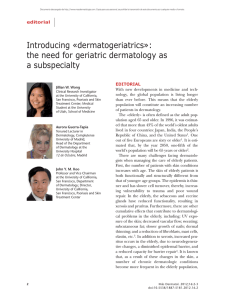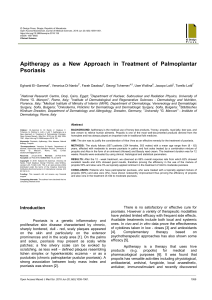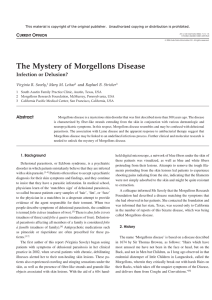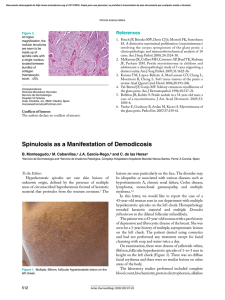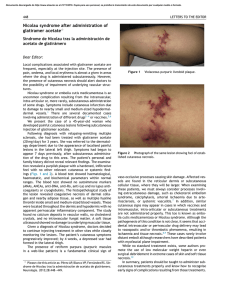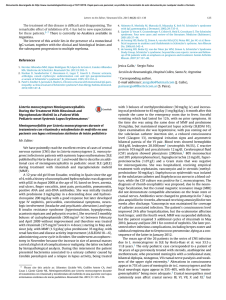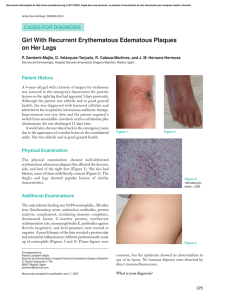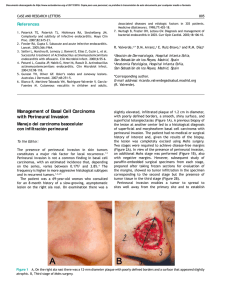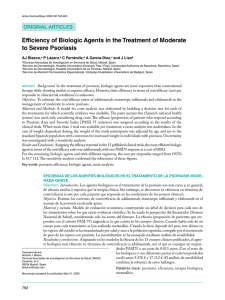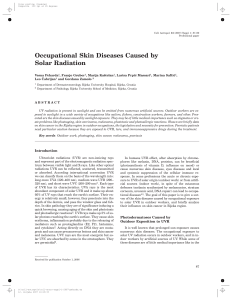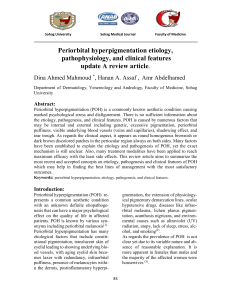THE BURNING MOUTH SYNDROME
Anuncio
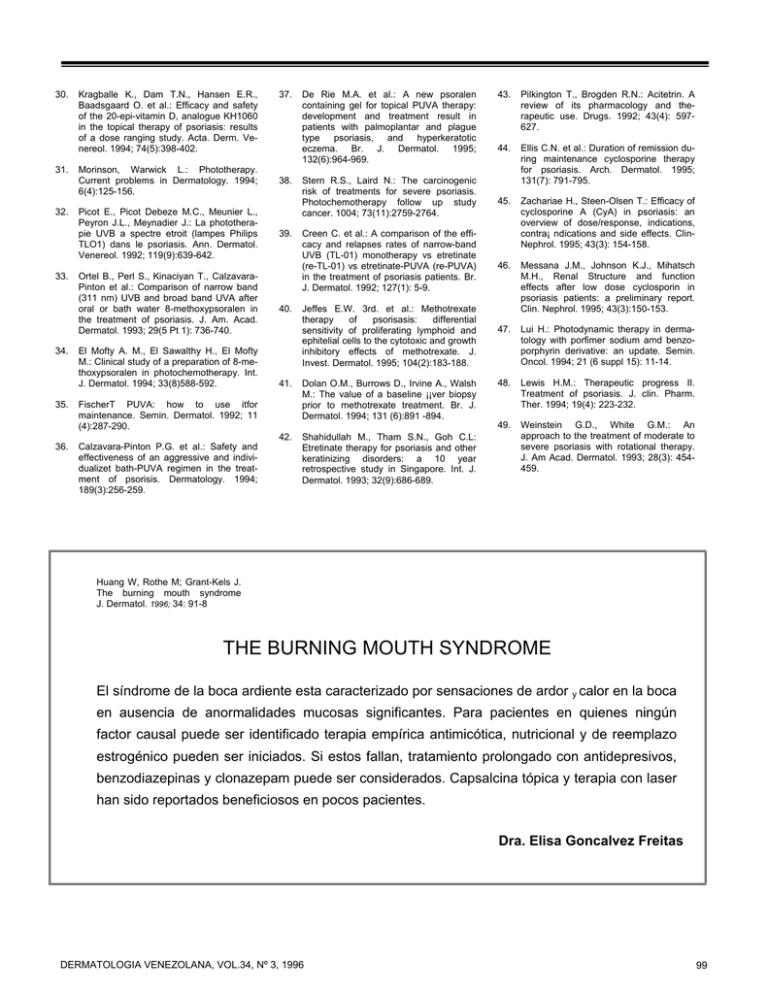
30. 31. 32. 33. 34. 35. 36. Kragballe K., Dam T.N., Hansen E.R., Baadsgaard O. et al.: Efficacy and safety of the 20-epi-vitamin D, analogue KH1060 in the topical therapy of psoriasis: results of a dose ranging study. Acta. Derm. Venereol. 1994; 74(5):398-402. Morinson, Warwick L.: Phototherapy. Current problems in Dermatology. 1994; 6(4):125-156. Picot E., Picot Debeze M.C., Meunier L., Peyron J.L., Meynadier J.: La phototherapie UVB a spectre etroit (lampes Philips TLO1) dans le psoriasis. Ann. Dermatol. Venereol. 1992; 119(9):639-642. Ortel B., Perl S., Kinaciyan T., CalzavaraPinton et al.: Comparison of narrow band (311 nm) UVB and broad band UVA after oral or bath water 8-methoxypsoralen in the treatment of psoriasis. J. Am. Acad. Dermatol. 1993; 29(5 Pt 1): 736-740. El Mofty A. M., El Sawalthy H., El Mofty M.: Clinical study of a preparation of 8-methoxypsoralen in photochemotherapy. Int. J. Dermatol. 1994; 33(8)588-592. 37. 38. 39. 40. 43. Pilkington T., Brogden R.N.: Acitetrin. A review of its pharmacology and therapeutic use. Drugs. 1992; 43(4): 597627. 44. Stern R.S., Laird N.: The carcinogenic risk of treatments for severe psoriasis. Photochemotherapy follow up study cancer. 1004; 73(11):2759-2764. Ellis C.N. et al.: Duration of remission during maintenance cyclosporine therapy for psoriasis. Arch. Dermatol. 1995; 131(7): 791-795. 45. Creen C. et al.: A comparison of the efficacy and relapses rates of narrow-band UVB (TL-01) monotherapy vs etretinate (re-TL-01) vs etretinate-PUVA (re-PUVA) in the treatment of psoriasis patients. Br. J. Dermatol. 1992; 127(1): 5-9. Zachariae H., Steen-Olsen T.: Efficacy of cyclosporine A (CyA) in psoriasis: an overview of dose/response, indications, contra¡ ndications and side effects. ClinNephrol. 1995; 43(3): 154-158. 46. Messana J.M., Johnson K.J., Mihatsch M.H., Renal Structure and function effects after low dose cyclosporin in psoriasis patients: a preliminary report. Clin. Nephrol. 1995; 43(3):150-153. 47. Lui H.: Photodynamic therapy in dermatology with porfimer sodium amd benzoporphyrin derivative: an update. Semin. Oncol. 1994; 21 (6 suppl 15): 11-14. 48. Lewis H.M.: Therapeutic progress II. Treatment of psoriasis. J. clin. Pharm. Ther. 1994; 19(4): 223-232. 49. Weinstein G.D., White G.M.: An approach to the treatment of moderate to severe psoriasis with rotational therapy. J. Am Acad. Dermatol. 1993; 28(3): 454459. Jeffes E.W. 3rd. et al.: Methotrexate therapy of psorisasis: differential sensitivity of proliferating lymphoid and ephitelial cells to the cytotoxic and growth inhibitory effects of methotrexate. J. Invest. Dermatol. 1995; 104(2):183-188. 41. Dolan O.M., Burrows D., Irvine A., Walsh M.: The value of a baseline ¡¡ver biopsy prior to methotrexate treatment. Br. J. Dermatol. 1994; 131 (6):891 -894. 42. Shahidullah M., Tham S.N., Goh C.L: Etretinate therapy for psoriasis and other keratinizing disorders: a 10 year retrospective study in Singapore. Int. J. Dermatol. 1993; 32(9):686-689. FischerT PUVA: how to use itfor maintenance. Semin. Dermatol. 1992; 11 (4):287-290. Calzavara-Pinton P.G. et al.: Safety and effectiveness of an aggressive and individualizet bath-PUVA regimen in the treatment of psorisis. Dermatology. 1994; 189(3):256-259. De Rie M.A. et al.: A new psoralen containing gel for topical PUVA therapy: development and treatment result in patients with palmoplantar and plague type psoriasis, and hyperkeratotic eczema. Br. J. Dermatol. 1995; 132(6):964-969. Huang W, Rothe M; Grant-Kels J. The burning mouth syndrome J. Dermatol. 1996; 34: 91-8 THE BURNING MOUTH SYNDROME El síndrome de la boca ardiente esta caracterizado por sensaciones de ardor y calor en la boca en ausencia de anormalidades mucosas significantes. Para pacientes en quienes ningún factor causal puede ser identificado terapia empírica antimicótica, nutricional y de reemplazo estrogénico pueden ser iniciados. Si estos fallan, tratamiento prolongado con antidepresivos, benzodiazepinas y clonazepam puede ser considerados. Capsalcina tópica y terapia con laser han sido reportados beneficiosos en pocos pacientes. Dra. Elisa Goncalvez Freitas DERMATOLOGIA VENEZOLANA, VOL.34, Nº 3, 1996 99
